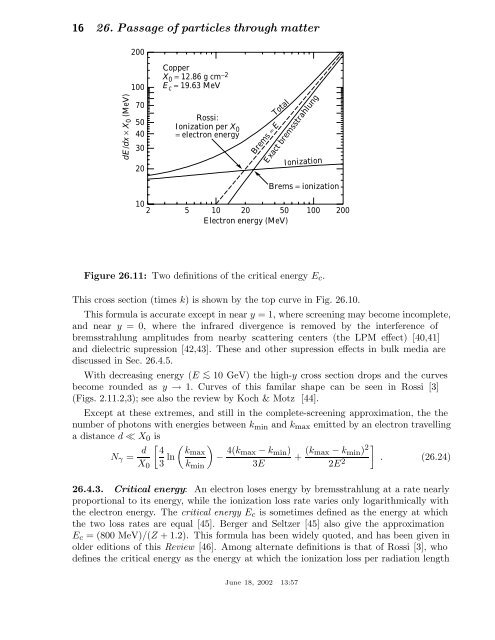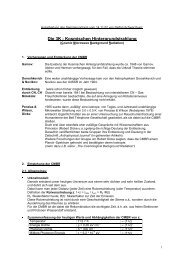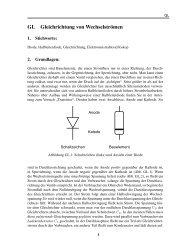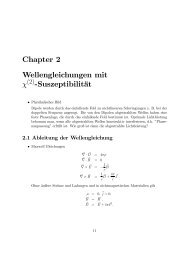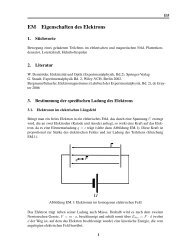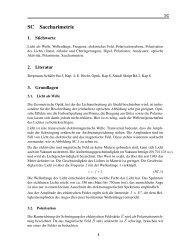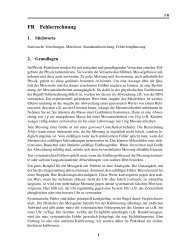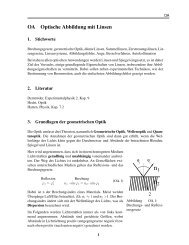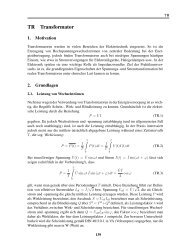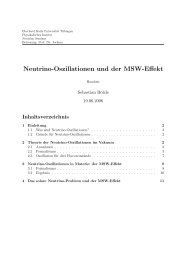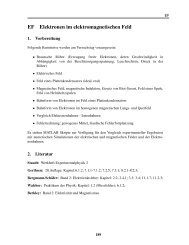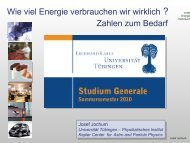26. passage of particles through matter - Particle Data Group
26. passage of particles through matter - Particle Data Group
26. passage of particles through matter - Particle Data Group
You also want an ePaper? Increase the reach of your titles
YUMPU automatically turns print PDFs into web optimized ePapers that Google loves.
16 <strong>26.</strong> Passage <strong>of</strong> <strong>particles</strong> <strong>through</strong> <strong>matter</strong><br />
200<br />
dE/dx × X 0 (MeV)<br />
100<br />
70<br />
50<br />
40<br />
30<br />
20<br />
Copper<br />
X 0 = 12.86 g cm −2<br />
E c = 19.63 MeV<br />
Rossi:<br />
Ionization per X 0<br />
= electron energy<br />
Brems ≈ E<br />
Total<br />
Ionization<br />
Exact bremsstrahlung<br />
Brems = ionization<br />
10<br />
2 5 10 20 50 100 200<br />
Electron energy (MeV)<br />
Figure <strong>26.</strong>11: Two definitions <strong>of</strong> the critical energy E c .<br />
This cross section (times k) is shown by the top curve in Fig. <strong>26.</strong>10.<br />
This formula is accurate except in near y = 1, where screening may become incomplete,<br />
and near y = 0, where the infrared divergence is removed by the interference <strong>of</strong><br />
bremsstrahlung amplitudes from nearby scattering centers (the LPM effect) [40,41]<br />
and dielectric supression [42,43]. These and other supression effects in bulk media are<br />
discussed in Sec. <strong>26.</strong>4.5.<br />
With decreasing energy (E < ∼ 10 GeV) the high-y cross section drops and the curves<br />
become rounded as y → 1. Curves <strong>of</strong> this familar shape can be seen in Rossi [3]<br />
(Figs. 2.11.2,3); see also the review by Koch & Motz [44].<br />
Except at these extremes, and still in the complete-screening approximation, the the<br />
number <strong>of</strong> photons with energies between k min and k max emitted by an electron travelling<br />
adistanced≪X 0 is<br />
N γ =<br />
d [ ( )<br />
4<br />
X 0 3 ln kmax<br />
− 4(k max − k min )<br />
+ (k max − k min ) 2 ]<br />
k min 3E<br />
2E 2 . (<strong>26.</strong>24)<br />
<strong>26.</strong>4.3. Critical energy: An electron loses energy by bremsstrahlung at a rate nearly<br />
proportional to its energy, while the ionization loss rate varies only logarithmically with<br />
the electron energy. The critical energy E c is sometimes defined as the energy at which<br />
the two loss rates are equal [45]. Berger and Seltzer [45] also give the approximation<br />
E c = (800 MeV)/(Z +1.2). This formula has been widely quoted, and has been given in<br />
older editions <strong>of</strong> this Review [46]. Among alternate definitions is that <strong>of</strong> Rossi [3], who<br />
defines the critical energy as the energy at which the ionization loss per radiation length<br />
June 18, 2002 13:57


